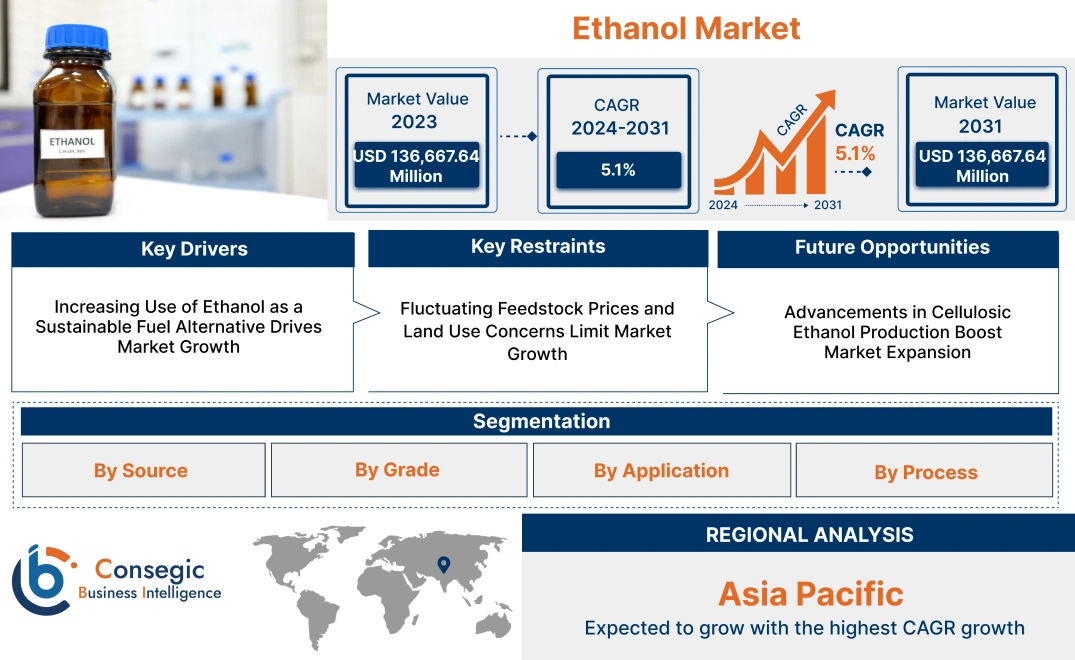- Summary
- Table Of Content
- Methodology
Ethanol Market Size:
Ethanol Market size is estimated to reach over USD 136,667.64 Million by 2031 from a value of USD 93,438.50 Million in 2023, growing at a CAGR of 5.1% from 2024 to 2031.
Ethanol Market Scope & Overview:
The ethanol market centers around the production and utilization of ethanol, a renewable biofuel derived primarily from corn, sugarcane, and other biomass sources. Ethanol is widely used as an additive in gasoline to increase octane levels and reduce carbon emissions, contributing to cleaner combustion. It serves as a versatile solvent in industries like pharmaceuticals, cosmetics, and chemicals, and is also utilized in the production of alcoholic beverages. Key characteristics of ethanol include its biodegradability, high energy content, and compatibility with existing fuel infrastructure. The benefits of ethanol include reduced greenhouse gas emissions, enhanced fuel efficiency, and support for energy independence. The applications of ethanol extend to automotive fuels, industrial solvents, personal care products, and alcoholic beverages. The primary end-use industries include transportation, pharmaceuticals, food & beverages, and chemicals, driven by rising environmental concerns and regulatory mandates promoting renewable fuel adoption.
Ethanol Market Dynamics - (DRO) :
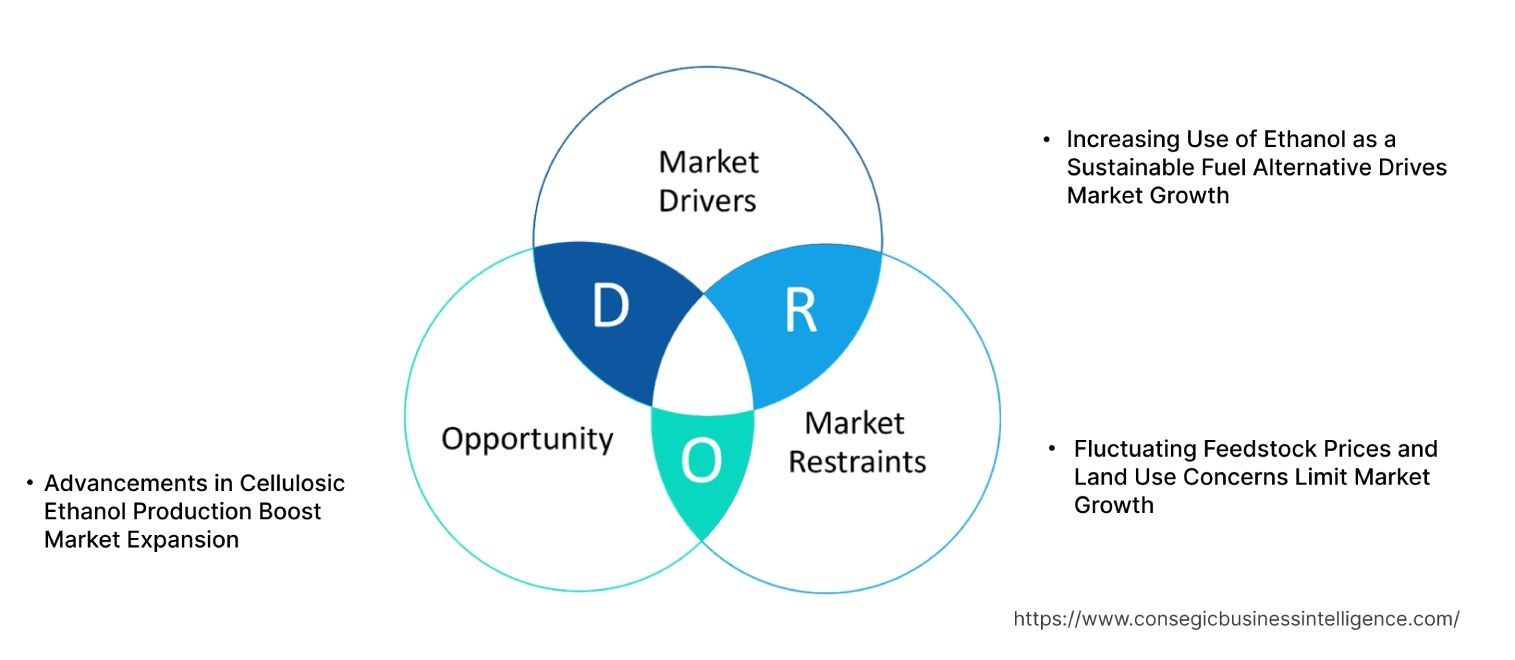
Key Drivers:
Increasing Use of Ethanol as a Sustainable Fuel Alternative Drives Market Growth
The growing emphasis on reducing carbon emissions and finding renewable energy sources is a major driver for the ethanol market. Ethanol, a biofuel derived from crops like corn and sugarcane, is increasingly used as a sustainable alternative to fossil fuels in the transportation sector. The adoption of ethanol-blended fuels (such as E10 and E85) helps lower greenhouse gas emissions, reduce reliance on crude oil, and promote cleaner air. Government regulations and incentives aimed at promoting biofuels, along with mandates for fuel blending, are further accelerating the ethanol market demand. Additionally, the expanding use of ethanol as a fuel additive in the automotive and aviation sectors is boosting ethanol market growth, driven by the need for eco-friendly energy solutions.
Key Restraints :
Fluctuating Feedstock Prices and Land Use Concerns Limit Market Growth
The ethanol market faces significant challenges due to the volatility of feedstock prices and concerns over land use. Ethanol production primarily relies on crops like corn, sugarcane, and wheat, whose prices are influenced by factors such as weather conditions, crop yields, and ethanol market demand for food. Price fluctuations directly impact the profitability of ethanol producers, making the market vulnerable to agricultural disruptions. Additionally, the large-scale cultivation of feedstock for ethanol raises concerns about land use, as it competes with food production and may lead to deforestation. The environmental impact of converting arable land for biofuel crops has sparked debates about the sustainability of ethanol, further restraining ethanol market growth.
Future Opportunities :
Advancements in Cellulosic Ethanol Production Boost Market Expansion
The development of cellulosic ethanol offers a promising for the ethanol market opportunity. Unlike conventional ethanol, cellulosic ethanol is produced from non-food biomass, such as agricultural residues, wood chips, and dedicated energy crops, reducing the competition with food production and minimizing the environmental impact. Recent advancements in enzyme technology and bioconversion processes have improved the efficiency of cellulosic ethanol production, making it a more viable alternative. The growing interest in advanced biofuels and increasing ethanol market opportunity for government support for low-carbon energy sources are expected to drive the adoption of cellulosic ethanol, creating new growth avenues for market participants focused on sustainable and eco-friendly fuel solutions.
Ethanol Market Segmental Analysis :
By Source :
Based on the source, the ethanol market is segmented into corn-based ethanol, sugarcane-based ethanol, wheat-based ethanol, barley-based ethanol, cellulosic ethanol, and others.
The corn-based ethanol segment accounted for the largest revenue share of 33.12% of the ethanol market share in 2023.
- Corn-based ethanol dominates the market due to its extensive use in the production of biofuels, particularly in North America.
- The U.S., a leading producer of ethanol, primarily utilizes corn as the feedstock due to its abundant availability and efficient fermentation process.
- Corn ethanol is widely adopted as a fuel additive to reduce greenhouse gas emissions and enhance fuel efficiency.
- Additionally, ongoing advancements in corn-to-ethanol conversion technologies, including enzyme innovations, have further strengthened the position of this segment.
- Corn-based ethanol leads the market trends, driven by its widespread use in biofuel production and continuous advancements in conversion technologies.
The cellulosic ethanol segment is anticipated to register the fastest CAGR during the forecast period.
- Cellulosic ethanol, derived from non-food biomass such as agricultural residues and woody crops, is gaining traction as a sustainable alternative to conventional ethanol sources.
- The environmental benefits of cellulosic ethanol, including lower carbon emissions and reduced reliance on food-based feedstocks, are driving its adoption.
- Governments globally are promoting cellulosic ethanol through favorable policies and funding for research and development, further accelerating its growth.
- Therefore, the segmental ethanol market analysis shows cellulosic ethanol is expected to grow rapidly, supported by its environmental benefits and increasing opportunities for government initiatives promoting sustainable biofuel alternatives evolving in the ethanol market trend.
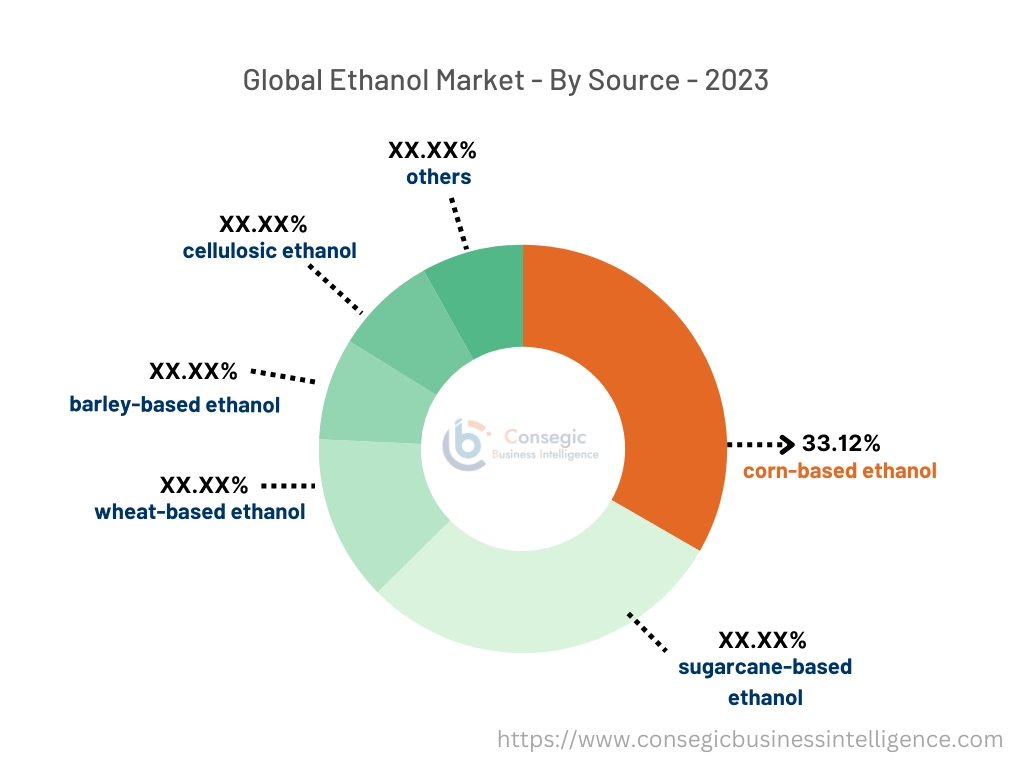
By Grade:
Based on grade, the ethanol market is segmented into fuel-grade ethanol, industrial-grade ethanol, food-grade ethanol, and pharmaceutical-grade ethanol.
The fuel-grade ethanol segment accounted for the largest revenue share in 2023.
- Fuel-grade ethanol is extensively used as a biofuel additive in gasoline to reduce emissions and enhance engine performance.
- Countries like the U.S., Brazil, and members of the EU have mandated the blending of ethanol with gasoline, significantly driving the trend for fuel-grade ethanol.
- The transition to cleaner energy sources and the ethanol market expansion of flex-fuel vehicles are further boosting this segment.
- Therefore, according to the analysis fuel-grade ethanol dominates the market due to its widespread adoption in gasoline blending programs trends and its role in supporting clean energy initiatives.
The pharmaceutical-grade ethanol segment is anticipated to register the fastest CAGR during the forecast period.
- Pharmaceutical-grade ethanol is witnessing increasing demand as a key ingredient in drug formulations, disinfectants, and sanitizers.
- Its high purity and antiseptic properties make it indispensable in healthcare applications.
- The COVID-19 pandemic highlighted the critical role of ethanol in sanitizer production, leading to increased investments in pharmaceutical-grade ethanol manufacturing facilities.
- As Healthcare sectors expand globally, this segment is expected to grow significantly.
- Thus, according to the analysis pharmaceutical-grade ethanol is expected to grow rapidly, driven by its critical role in the healthcare industry and the rising demand for high-purity ethanol in pharmaceutical formulations and sanitizers.
By Application:
Based on application, the ethanol market is segmented into biofuel , industrial solvents, disinfectants & sanitizers, cosmetic formulations, and chemical intermediates.
The biofuel segment accounted for the largest revenue share in 2023.
- Ethanol is a key component in biofuel production, particularly in ethanol-blended gasoline used to reduce emissions and enhance fuel efficiency.
- The increasing adoption of renewable energy sources and government mandates on ethanol blending in gasoline, such as the Renewable Fuel Standard (RFS) in the U.S. and similar programs in Brazil and the EU, are driving this segment.
- The shift toward achieving net-zero carbon emissions further underscores the importance of ethanol in the biofuel industry.
- Thus, the segmental analysis depicts the biofuel segment leading the ethanol market trends due to its widespread use in gasoline blending and its critical role in overall efforts to transition to renewable energy ethanol market trends.
The disinfectants & sanitizers segment is anticipated to register the fastest CAGR during the forecast period.
- Ethanol is a primary ingredient in disinfectants and sanitizers due to its strong antimicrobial properties.
- The demand for sanitizers surged during the COVID-19 pandemic, and the heightened focus on hygiene and infection control continues to drive this segment.
- Increasing adoption of ethanol-based disinfectants in healthcare, commercial, and residential sectors is fueling the growth of this application.
- Hence, the analysis of the disinfectants & sanitizers segment is expected to grow rapidly, driven by heightened hygiene awareness and the growing adoption of ethanol-based antimicrobial product trends.
By Process:
Based on process, the ethanol market is segmented into biobased and synthetic ethanol.
The biobased process accounted for the largest revenue share in 2023..
- Biobased or fermentation is the most widely used method for ethanol production, relying on the enzymatic breakdown of sugars derived from corn, sugarcane, and other feedstocks.
- The efficiency and scalability of fermentation, along with its compatibility with a variety of raw materials, make it the preferred choice for ethanol manufacturing.
- The ongoing advancements in fermentation technologies, including the use of genetically modified yeast strains, are further enhancing the efficiency of this process.
- Hence, the fermentation process dominates the market trends due to its widespread adoption of continuous technological ethanol market analysis advancements that enhance its efficiency and scalability.
The synthetic ethanol segment is anticipated to register the fastest CAGR during the forecast period.
- Synthetic ethanol, produced via the chemical hydration of ethylene, is gaining traction due to its high purity and reliability in industrial applications.
- The demand for synthetic ethanol is rising in regions with limited availability of agricultural feedstocks, as well as in industries requiring consistent and contaminant-free ethanol, such as pharmaceuticals and cosmetics.
- Hence, the synthetic ethanol analysis depicts the expected rise which is, driven by its high purity and increasing adoption in industrial and pharmaceutical applications trends, particularly in regions with limited agricultural resources.
Regional Analysis:
The regions covered are North America, Europe, Asia Pacific, the Middle East and Africa, and Latin America.
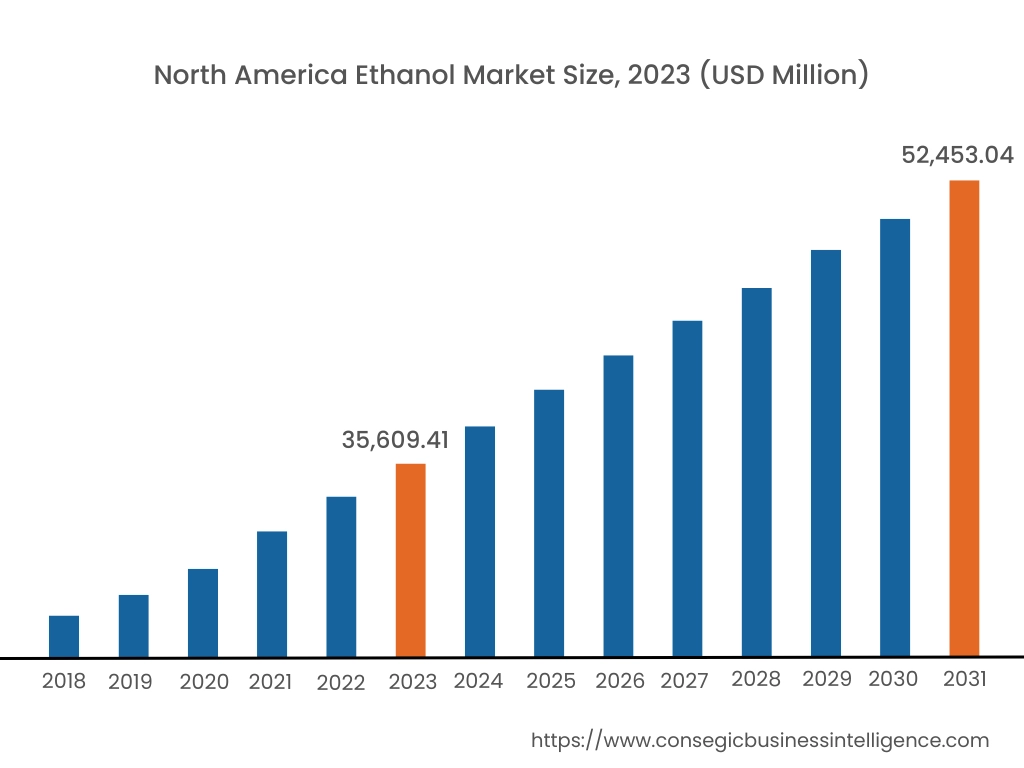
In 2023, North America accounted for the highest market share at 38.11% and was valued at USD 35,609.41 Million and is expected to reach USD 52,453.04 Million in 2031. In North America, the U.S. accounted for the highest share of 67.11% during the base year of 2023. North America dominates the ethanol market, with the United States being a major producer and exporter of ethanol, primarily derived from corn. The demand for ethanol in the region is driven by government mandates promoting the use of renewable fuels and blending ethanol with gasoline to reduce carbon emissions.
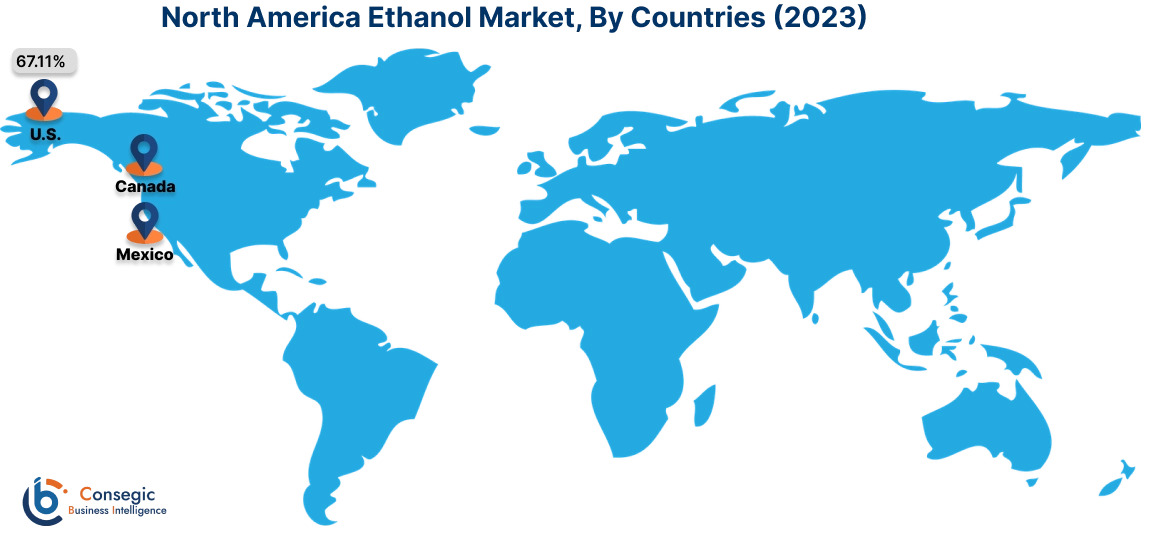
In Asia Pacific, the market is experiencing the fastest growth with a CAGR of 5.7% over the forecast period. The Asia-Pacific ethanol market is growing rapidly, driven by increasing energy needs and government initiatives to promote biofuels. Countries like China and India are ramping up ethanol production using locally available feedstocks, such as sugarcane and molasses, to reduce reliance on imported fossil fuels.
Europe is a significant market for ethanol, with its adoption influenced by stringent environmental regulations and the push for renewable energy sources. The production of ethanol in Europe focuses on sustainable feedstocks, such as sugar beet and wheat, to align with the region's sustainability goals.
The ethanol market in the Middle East and Africa is gradually emerging, supported by growing interest in alternative energy sources. While the region has limited production capabilities, governments are exploring ethanol's potential as a renewable energy solution to diversify their energy mix.
Latin America, led by Brazil, is a global leader in ethanol production, with sugarcane being the primary feedstock. Ethanol is widely used in transportation, supported by government policies promoting biofuel usage as part of sustainable energy strategies. Brazil's well-established ethanol infrastructure positions the region as a key player in the global ethanol market.
Top Key Players & Market Share Insights:
The ethanol market is highly competitive with major players providing products and services to the national and international markets. Key players are adopting several strategies in research and development (R&D), product innovation, and end-user launches to hold a strong position in the global ethanol market. Key players in the ethanol industry include -
- Archer Daniels Midland Company (ADM) (United States)
- Valero Energy Corporation (United States)
- POET, LLC (United States)
- Green Plains Inc. (United States)
- BP p.l.c. (United Kingdom)
- Royal Dutch Shell plc (Netherlands)
- Pacific Ethanol, Inc. (United States)
- Flint Hills Resources (United States)
- Abengoa Bioenergy (Spain)
- Cargill, Incorporated (United States)
Recent Industry Developments :
- In April 2024, the U.S. Environmental Protection Agency (EPA) announced a temporary expansion of higher-ethanol gasoline sales to mitigate potential supply disruptions caused by ongoing conflicts in Ukraine and the Middle East. The decision made public in a letter from the EPA, allows for the continued sale of E15, a gasoline blend containing 15% ethanol, during the summer months. This marks the third consecutive year the administration has extended the period for E15 sales, which are typically restricted from June 1 to September 15
Ethanol Market Report Insights :
| Report Attributes | Report Details |
| Study Timeline | 2018-2031 |
| Market Size in 2031 | USD 136,667.64 Million |
| CAGR (2024-2031) | 5.1% |
| By Source |
|
| By Process |
|
| By Application |
|
| By Grade |
|
| By Region |
|
| Key Players |
|
| North America | U.S. Canada Mexico |
| Europe | U.K. Germany France Spain Italy Russia Benelux Rest of Europe |
| APAC | China South Korea Japan India Australia ASEAN Rest of Asia-Pacific |
| Middle East and Africa | GCC Turkey South Africa Rest of MEA |
| LATAM | Brazil Argentina Chile Rest of LATAM |
| Report Coverage |
|
Key Questions Answered in the Report
What is the size of the ethanol market? +
Ethanol Market size is estimated to reach over USD 136,667.64 Million by 2031 from a value of USD 93,438.50 Million in 2023, growing at a CAGR of 5.1% from 2024 to 2031.
What are the key drivers of the ethanol market? +
Key drivers include the growing demand for renewable energy sources, government mandates for biofuel blending, and environmental concerns regarding greenhouse gas emissions.
What are the main feedstocks used in ethanol production? +
The primary feedstocks for ethanol production are corn, sugarcane, and wheat, with corn being the dominant feedstock in North America and sugarcane in Brazil.
What is the ethanol market segmentation by application? +
The ethanol market is segmented into transportation fuels, industrial solvents, and beverages. The transportation sector holds the largest share due to the demand for ethanol-blended gasoline.
What are the regional trends in the ethanol market? +
North America and Brazil are major ethanol producers, with the United States leading in ethanol from corn and Brazil focusing on sugarcane. The market is also expanding in Asia-Pacific due to increasing energy needs.
